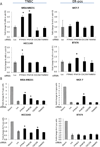Phosphatase PTP4A3 Promotes Triple-Negative Breast Cancer Growth and Predicts Poor Patient Survival
- PMID: 26921331
- PMCID: PMC4873402
- DOI: 10.1158/0008-5472.CAN-14-0673
Phosphatase PTP4A3 Promotes Triple-Negative Breast Cancer Growth and Predicts Poor Patient Survival
Abstract
Triple-negative breast cancer (TNBC) has the worst prognosis of all breast cancers, and women diagnosed with TNBC currently lack targeted treatment options. To identify novel targets for TNBC, we evaluated phosphatase expression in breast tumors and characterized their contributions to in vitro and in vivo growth of TNBC. Using Affymetrix microarray analysis of 102 breast cancers, we identified 146 phosphatases that were significantly differentially expressed in TNBC compared with estrogen receptor (ER)-positive tumors. Of these, 19 phosphatases were upregulated (0.66-fold; FDR = 0.05) in TNBC compared with ER-positive breast cancers. We knocked down 17 overexpressed phosphatases in four triple-negative and four ER-positive breast cancer lines using specific siRNAs and found that depletion of six of these phosphatases significantly reduced growth and anchorage-independent growth of TNBC cells to a greater extent than ER-positive cell lines. Further analysis of the phosphatase PTP4A3 (also known as PRL-3) demonstrated its requirement for G1-S cell-cycle progression in all breast cancer cells, but PTP4A3 regulated apoptosis selectively in TNBC cells. In addition, PTP4A3 inhibition reduced the growth of TNBC tumors in vivo Moreover, in silico analysis revealed the PTP4A3 gene to be amplified in 29% of basal-like breast cancers, and high expression of PTP4A3 could serve as an independent prognostic indicator for worse overall survival. Collectively, these studies define the importance of phosphatase overexpression in TNBC and lay the foundation for the development of new targeted therapies directed against phosphatases or their respective signaling pathways for TNBC patients. Cancer Res; 76(7); 1942-53. ©2016 AACR.
©2016 American Association for Cancer Research.
Conflict of interest statement
All remaining authors declare no actual, potential, or perceived conflict of interest that would prejudice the impartiality of this article.
Figures





Similar articles
-
PRL-3 engages the focal adhesion pathway in triple-negative breast cancer cells to alter actin structure and substrate adhesion properties critical for cell migration and invasion.Cancer Lett. 2016 Oct 1;380(2):505-512. doi: 10.1016/j.canlet.2016.07.017. Epub 2016 Jul 21. Cancer Lett. 2016. PMID: 27452906 Free PMC article.
-
Genome-wide functional genetic screen with the anticancer agent AMPI-109 identifies PRL-3 as an oncogenic driver in triple-negative breast cancers.Oncotarget. 2016 Mar 29;7(13):15757-71. doi: 10.18632/oncotarget.7462. Oncotarget. 2016. PMID: 26909599 Free PMC article.
-
Analysis of phosphatases in ER-negative breast cancers identifies DUSP4 as a critical regulator of growth and invasion.Breast Cancer Res Treat. 2016 Aug;158(3):441-54. doi: 10.1007/s10549-016-3892-y. Epub 2016 Jul 8. Breast Cancer Res Treat. 2016. PMID: 27393618 Free PMC article.
-
Upregulation of protein tyrosine phosphatase type IVA member 3 (PTP4A3/PRL-3) is associated with tumor differentiation and a poor prognosis in human hepatocellular carcinoma.Ann Surg Oncol. 2013 Jan;20(1):305-17. doi: 10.1245/s10434-012-2395-2. Epub 2012 Oct 13. Ann Surg Oncol. 2013. PMID: 23064776 Free PMC article.
-
Cystine/cysteine metabolism regulates the progression and response to treatment of triple‑negative breast cancer (Review).Oncol Lett. 2024 Aug 30;28(5):521. doi: 10.3892/ol.2024.14654. eCollection 2024 Nov. Oncol Lett. 2024. PMID: 39268159 Free PMC article. Review.
Cited by
-
Thioredoxin Downregulation Enhances Sorafenib Effects in Hepatocarcinoma Cells.Antioxidants (Basel). 2019 Oct 22;8(10):501. doi: 10.3390/antiox8100501. Antioxidants (Basel). 2019. PMID: 31652503 Free PMC article.
-
Txnrd1 as a prognosticator for recurrence, metastasis and response to neoadjuvant chemotherapy and radiotherapy in breast cancer patients.Heliyon. 2024 Feb 29;10(6):e27011. doi: 10.1016/j.heliyon.2024.e27011. eCollection 2024 Mar 30. Heliyon. 2024. PMID: 38524569 Free PMC article.
-
PRL-3 engages the focal adhesion pathway in triple-negative breast cancer cells to alter actin structure and substrate adhesion properties critical for cell migration and invasion.Cancer Lett. 2016 Oct 1;380(2):505-512. doi: 10.1016/j.canlet.2016.07.017. Epub 2016 Jul 21. Cancer Lett. 2016. PMID: 27452906 Free PMC article.
-
In-gel digestion coupled with mass spectrometry (GeLC-MS/MS)-based salivary proteomic profiling of canine oral tumors.BMC Vet Res. 2020 Sep 14;16(1):335. doi: 10.1186/s12917-020-02550-w. BMC Vet Res. 2020. PMID: 32928212 Free PMC article.
-
Expression of phosphatase of regenerating liver (PRL)-3, is independently associated with biochemical failure, clinical failure and death in prostate cancer.PLoS One. 2017 Nov 30;12(11):e0189000. doi: 10.1371/journal.pone.0189000. eCollection 2017. PLoS One. 2017. PMID: 29190795 Free PMC article.
References
-
- Siegel R, Naishadham D, Jemal A. Cancer statistics, 2013. CA Cancer J Clin. 2013;63(1):11–30. - PubMed
-
- Carey LA, Perou CM, Livasy CA, Dressler LG, Cowan D, Conway K, et al. Race, breast cancer subtypes, and survival in the Carolina Breast Cancer Study. JAMA. 2006;295(21):2492–2502. - PubMed
-
- Kaufman B, Trudeau M, Awada A, Blackwell K, Bachelot T, Salazar V, et al. Lapatinib monotherapy in patients with HER2-overexpressing relapsed or refractory inflammatory breast cancer: final results and survival of the expanded HER2+ cohort in EGF103009, a phase II study. Lancet Oncol. 2009;10(6):581–588. - PubMed
Publication types
MeSH terms
Substances
Grants and funding
LinkOut - more resources
Full Text Sources
Other Literature Sources
Molecular Biology Databases

